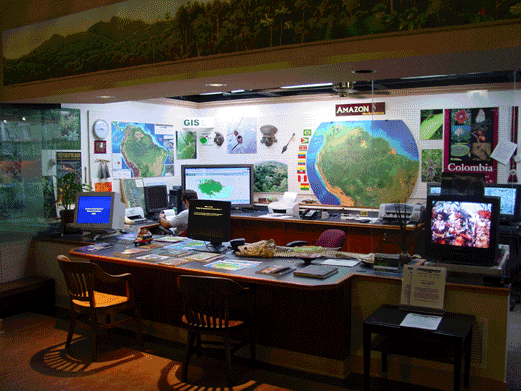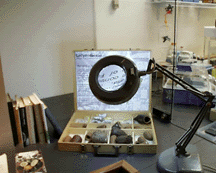



















Development of Dune Ecosystem Exhibit (decommissioned)
I had been engaged in helping design and plan for a new exhibit targeted at young audiences to be launched at The Dunes Center in southern California. The exhibit would feature research on dune ecosystems, large-format flat graphics, a 3-D interactive dune, and a small learning center with hands-on activities for children. The exhibit would have been designed for travel and would have incorporated audio and interactive visual aids.
SOS: Science on a Sphere, National Zoo - Amazonia Science Gallery
Photos courtesy of NZP
The Science on a Sphere (SOS) is a large US-based and networked program for education sponsored by NOAA. It involves a competitive grant application for exhibit installation. Physically, it is comprised of a large suspended, lightweight sphere with a multi projection system to cast an image (in this case, GIS and remotely sensed imagery) around the sphere. The end product is a dynamic and suspended globe from pole to pole. The sphere can become whatever the imagery is; Earth, the moon, other planets, the sun. In addition, PPT presentations and video can be incorporated into the display at several equidistant location on the sphere so your audience can surround the display during presentations and/or general streaming.
My involvement with the SOS at Amazonia of the National Zoo began primarily with discussions at the World Bank that had obtained one (full purchase), but ultimately did not use it. It was intended for the lobby of their headquarters in DC and later rejected. I had suggested it should be donated to the National Zoo's Amazonia exhibit. In order to further convince senior staff of the quality of the SOS, I organized an on-site visit to the only operating SOS in our vicinity at the time (NAUTICUS: Norfolk Maritime Museum). I set up the initial meetings with NOAA, organized and helped conduct on site evaluations with the NOAA team at the Amazonia exhibit (viability testing of exhibit space), and helped establish the initial application and budget. From that point, it went to senior level handling for completion. We were granted the SOS at Amazonia and it remains on display today. Soon after this, the Smithsonian's National Museum of Natural History also applied and received an SOS.
ESRI International User Conference
Conference exhibit:
Featured at the 2003 Esri (Environmental Systems Research Institute) International user Conference in San Diego, I worked with Esri to design the 30 x 30 foot exhibit consisting of several Smithsonian GIS programs. These exhibits consisted of reconfigured framed towers upon which posters and exhibit items were installed. Plants were brought in to establish a tropical theme. Additionally, computer stations, LCD presentation areas, and information tables were incorporated.
The Solid Terrain Modeling (STM) company created and awarded the Amazon GIS Project a 8 x 4 foot scale model of the Amazon region, which was the centerpiece for this exhibit area. The STM was at a 1:1 ratio scale on the actual curvature of the earth. Elevation data was enhanced 5x. Composite Landsat image printed on top revealing true land cover (2002 data). I co-coordinated the imagery with the National Geographic Society and Solid Terrain Modeling to produce this land-use imagery file.The Solid Terrain Model provides a touchable surface which acts as an incredible centerpiece to promote further use of geospatial tools for tropical ecosystem conservation.
The Amazon GIS Laboratory. National Zoo, Amazonia Science Gallery
Located at the Smithsonian's National Zoological Park in the Amazonia Science Gallery, I designed the interior of the Amazon GIS Project Laboratory by removing a previous installation, mounting the STM model in the background, positioning appropriate GIS computer stations and various visually appealing decor from the Amazon region. Cabinetry and the ability to remove the glass wall divider was per-established. This lab can be approached by visitors who can then interact with staff scientists and/or educators. See Graphic Design page for interior.
The interior had to look like a working lab - since it was a working lab. The challenge was keeping it "interesting looking" for those times there were no staff in the lab. I incorporated a lot of materials from the Amazon for decoration. Surveys have indicated that such areas had high retention rate for visitor observations.
On site laboratory display in a botanical garden (decommissioned)
Conceptual design for an exhibit in the Adolfo Ducke Botanical Garden, Manaus, Brasil. This entailed 3-D models fro the exhibit based on artwork, foam models, electronics, etc.. Work was contracted by the Smithsonian Office of Exhibits Central. My participation was strictly in helping to design the foam-cor model, where to place exhibit items, develop content for the exhibit, and how to connect the on-line content to this facility in Manaus.
Tropical Seed Display, hands-on
I designed this for a table surface in our Amazonia Science Gallery and intended for causal hands-on interaction. It is accompanied by a large magnifying glass with lighting, peer-reviewed science literature on the subject matter, and nearby books on botany and fruiting bodies. I also decorated the table surface with textiles from the Amazon, along with traditional baskets and other items as wall displays. Seeds donated by Dr. Scott Mori of the New York Botanical Garden were used to convert an artist's paint tray into a seed display (family Lecythidaceae). I designed and produced the background graphics (backed on on foam cor and fastened to the back of the upper lid), obtained the seeds, inserted all items into the tray. Each sections on the base of the tray contain an artist's rendition of the seeds placed there (artist: Lori Discoe) so they can returned easily by younger audiences by association with the image. The tray folds up with snapping locks for easy travel and mobility around the Amazonia Science Gallery.
Manual GIS exhibit, hands-on
This design was intended to basically be a manual form of GIS. Putting transparent layers together in such a way to create a mashable map of combined features - and tossing it on a light table. This involves use of an old x-ray table from our veterinary hospital (back lit) with transparency sheets of "data" layers that can be overlaid on top of each other to simulate GIS use. I used a GIS to design the maps and printed them on clear transparency sheets which were then laminated to thick grade, so as not to be too flexible. Corners were rounded for safety. A small wooden tray holds the collections of layers (road development, airports, political boundaries, etc..) while a computer screen runs a looping PPT on the use of the table and general Amazon geography and threats to its ecosystem. This is intended for casual use and personal exploration. Any two or more GIS layers (laminated sheets) can be stacked together for a mashable map of Amazon resources.
Brazil Nut Display, pull-out drawer
With a focus on Amazonia and Brazil, I created a Brazil nut display using standard flat graphics adhered to foam cor, which is cut and bent for a depression (where seeds are inserted) and raised from underneath with larger foam cor bracing. Plexi glas covers the surface and the entire display is embedded in a pull out drawer for exploration. Seeds are loose and fill the graphic for a natural and organic display.
Ocelot night camera display, pull-out drawer
This exhibit is intended to share interesting field research I conducted on ocelot (Leopardus pardalis) in South Texas. Since the technology at the time relied upon "slides" take from remotely operated cameras, I used those slides to show visitors what can be captured during such research. It becomes internally lit when pulled out by a kill switch. Printed in reverse on plastic translucent film, and flipped so that the print is protected from light fading. Areas for slides were cut out of the printed film for maximum light exposure underneath toward each individual slide. Since this is how actual slides are viewed for research (with a back lit table), I thought it would be good for a visitor to use it in the same way - with the addition of supportive graphics. Designed for exploration by kids at ground level.
Flourescent mineral display
These minerals were on loan from the National Museum of Natural History's Department of Gems and Minerals. The display features rocks and minerals that fluoresce under a set of 5 black UV lights, which I installed right above the minerals, but out of sight from viewers (Plexi-glass is a safeguard against harmful UV wavelengths should small children look up into the bulb area). I designed and produced the cover graphics to label each of the minerals seen below. The only reason for this small installation is to create improved ambiance in the seminar room as many of these display cases were empty. This improves mood lighting and creates an interesting feature when room is turned down for seminars, lectures, and presentations.


